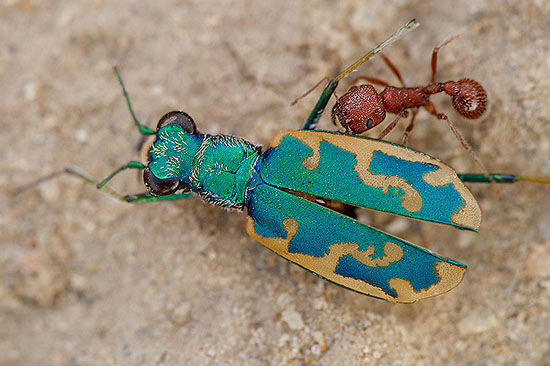Tiger Beetles are perfectly built creatures to kill. They are fast as hell, and what’s more, they are fastest running insects on earth. The fastest species of tiger beetle can run at a speed of 9 km per hour, which is about 53.87 body lengths per second. This means Usain Bolt, 1.95 metres tall, would be able to run almost 900 km per hour! This is more than twenty times faster than his top speed of 44,2 km per hour! At top speed its visual system cannot keep up, and it has to slow down to see anything… Speaking of lightning Bolt, Tiger Beetles strike really as fast as lightning when chasing their prey.
The image under here, perfectly illustrates the Tiger Beetle as a ‘lean mean killing machine’. Just take a look at these formidable jaws and imagine being chased by a creature running at a speed of 50 times his body length per second…

I spent several days in the South of Utah and in Arizona looking for Tiger Beetles. Despite their often striking appearance they can in general be pretty hard to detect.
Why so hard to find them?
Small, shy and fast
Tiger Beetles are small to medium-sized beetles (lengths mostly varying between 6 till 15 mm), but they are pretty shy and they can fly. They often already fly away at a distance of a few metres, so the tiny bug has usually vanished long before one has noticed it. Moreover, many of them are pretty well camouflaged when seen from above.
The right time and the right place
Many of the Tiger Beetle species which are active during the summer in the South of the USA, are mainly active at night or are crepuscular. During the most hot parts of the day (often 40+ C°), they hide in their burrows, which can be pretty deep. Some of them can appear in great numbers, just after a monsoon shower, when the temperature has cooled down a little too reasonable properties…
Ecological knowledge is often a key to success in finding animals, and although open bare sandy spots, as well as muddy banks are often interesting for Tiger Beetles, some species have very specific habitat demands within a pretty restricted range. These species can still be hard to find despite intensive searching.
To summarize, you have to be in the right place, during the right part of the year, and the right time of the day. I read a lot in advance about Tiger Beetles in the Field Guide to the Tiger Beetles of the United States and Canada (Pearson & All., 2006). This helped me already seriously in finding some Tiger Beetle species. Scanning carefully and slowly the favourite habitat of a Tiger Beetle is a first step. But in the end the tips and the precise information from ‘Tiger Beetle experts’ Ted MacRae, Stephen Spomer and Matt Brust, proved to be of major importance for some species and some nice colour variations. Barry Kinsley and David Pearson also were of great help in some tough ID discussions about a specimen found on the Kaibab Plateau. Many thanks to all of you!
I’ll start under here with some images of a green colour morph from a Punctured Tiger Beetle, Cicindela punctulata. The first image shows their typical habitat, consisting of open desert grasslands with bare soil. These images were taken in the surroundings of Kayenta, North Arizona.
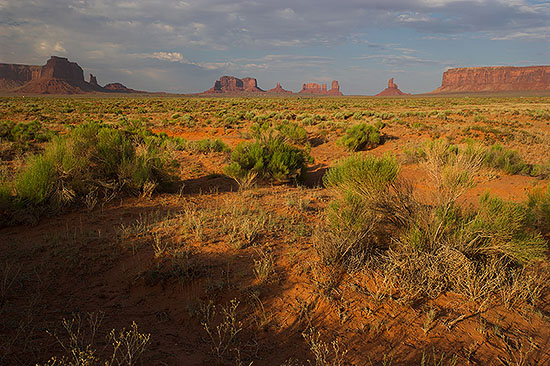
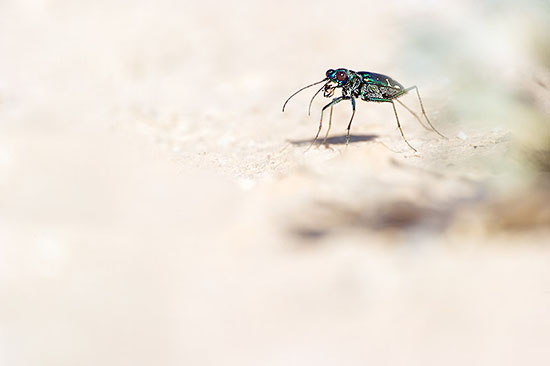

The ghost remains a ghost
In Chilchinbito, another desert grassland area at close vicinity, most of the specimens of the Punctured Tiger Beetles had a superb deep blue colour. During several hours I tried hard to find a Ghost Tiger beetle, Cicindela lepida, but the species remained faithful to its name… But on the other hand I got rewarded with some nice close range portraits from the Punctured Tiger Beetle. The first image shows an individual hiding in the shade of the grass cover. The next image shows the behaviour of a disturbed specimen: the species often hides in the higher grasses after it flew of.
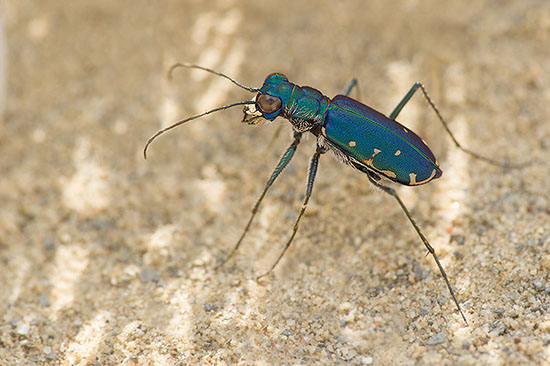
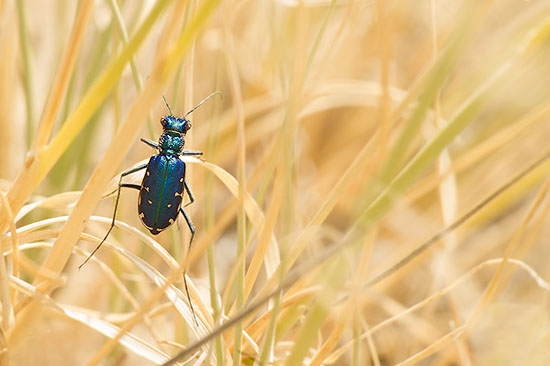
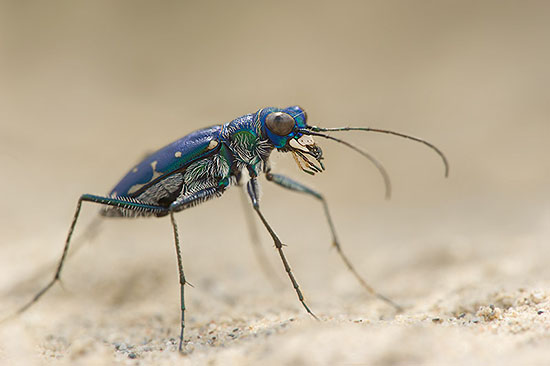
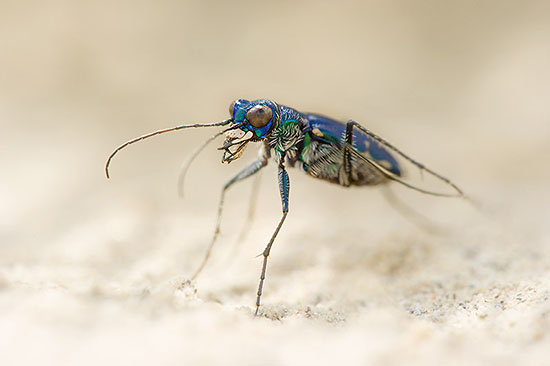
The next image shows a beautiful red colour morph of the Arid Land Tiger Beetle, Cicindela marutha. I found my first specimens at night under the lights of our hotel in Monument Valley (image one under). The next image shows the same species photographed at first light during the morning.

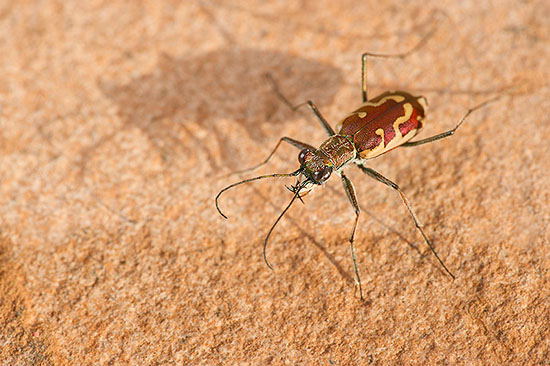
Under here some images from a Cow Path Tiger Beetle, Cicindela purpurea. I found a few specimens of this species on the short-grazed plateau grasslands of the Kaibab plateau.
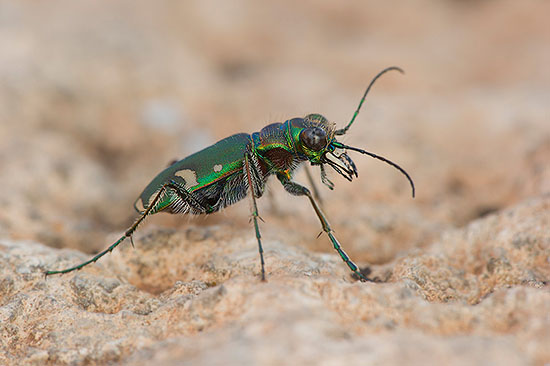
But the species I was looking for, a rare and extremely locally distributed species of the highest parts of the Kaibab plateau (Grand Canyon, North Rim) remained hidden for me on my first quests in the grasslands. After two afternoons of very slow and intensive searching in the grasslands, I finally managed to find two specimens of my target species: Cicindela terricola kaibabensis (Variable Tiger Beetle). The species is definitely uncommon and/or hiding very well in the higher grazy vegetation during dry summers…

On our way from the North Rim of the Grand Canyon to the South Rim, we stopped for a short while around Pasture Lake, just after a heavy midday downpour. As well described in Pearson & All. Many of the southern Tiger Beetle species can come out in great numbers after monsoon rains. No less than four species were running around on the muddy beaches around the lake. The most common was the green colour morph of Arid Land Tiger Beetles, but I found a few red specimens too. Under here some images form this splendid species:
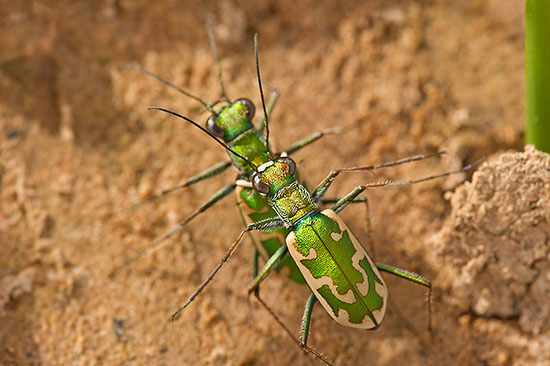
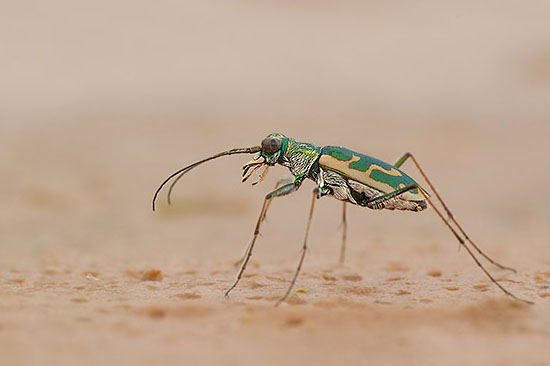
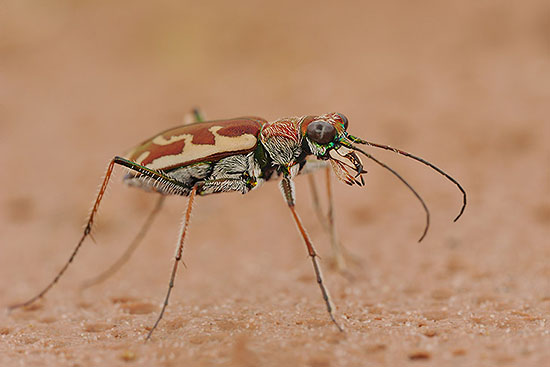
On the same spot, I photographed a beautiful dark coppery individual from Western Tiger Beetle, Cicindela oregona (image under here).
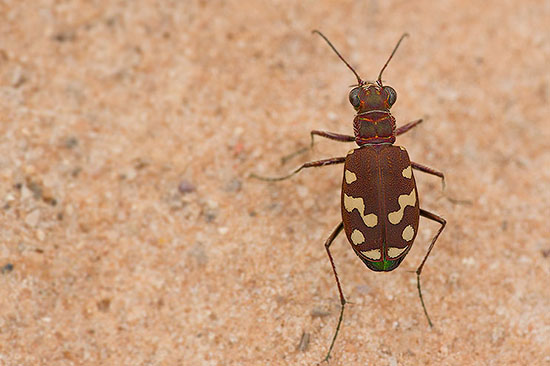
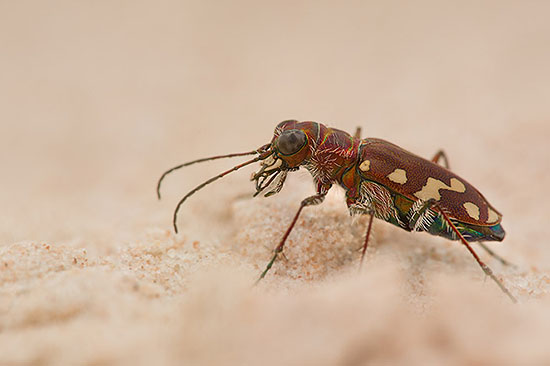
In Dead Horse Ranch State Park (Cottonwood, Central Arizona), I came across two tiny but beautiful coloured Tiger Beetle species: Pygmy Tiger Beetle, Cicindela viridisticta and White-lined Tiger Beetle, Cicindela lemniscata.
The Pygmy Tiger Beetle, Cicindela viridisticta, is a very small species, with a length varying from 7 to 9 mm. This tiny species is easily overlooked: it is very small and often quickly hides into the vegetation. Moreover, the species is often very well camouflaged on the brownish bare soil. When taking a closer look at this at first sight rather dull coloured Tiger Beetle, one can notice the beautiful pattern on its shields. Under here images from the species, followed by a detail of the splendid shield pattern.


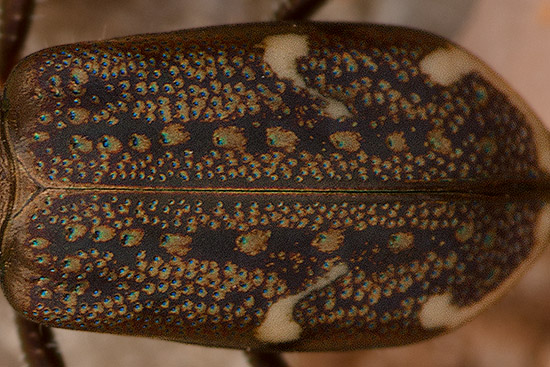
Many of the Tiger Beetle species which are active during the summer in the South of the USA, are mainly active at night. They are often attracted to bright lights. In particular after a heavy monsoon rain they can be attracted in hundreds to the lights of remote gasoline-filling stations.
Because it had rained very heavily during the afternoon, and the temperatures had cooled down a little bit, the White-striped Tiger Beetles had come out pretty early in the evening. There were hundreds of them running around very actively on an open field. Despite being so numerous, it took me a while before I noticed them. Despite their striking appearance, they were very well camouflaged on the reddish soil. It is only because I knew the circumstances were very good to observe the species that I found them after some active searching. Once I noticed one individual I saw that the entire field was plenty of others. At night I even saw several individuals in the middle of the city of Cottonwood! So the species can be really numerous during the humid evenings of the monsoon season.
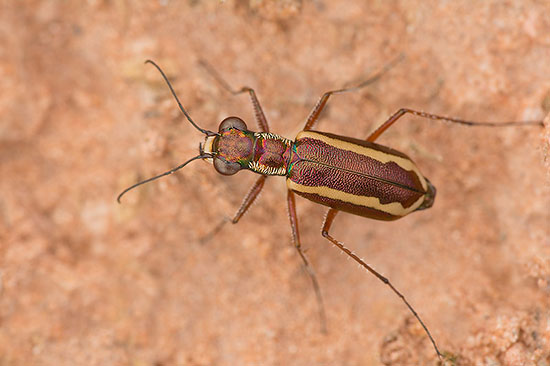
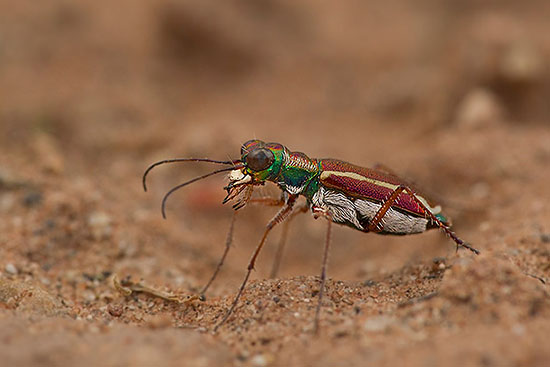
I’ll end with two of my favourite images, a green and a blue colour morph from the Arid Land Tiger Beetle. I'd also particularly like to thank Ted Macrae, Stephen Spomer and Matt Brust, for being so kind to provide me information about interesting places for Tiger Beetles. Ted, Stephen and Matt, as well as Barry Knisley and Dave Pearson were all of great help for the determination of some 'tricky species', such as a rather unusually patterned Cow Path Tiger Beetle, Cicindela purpurea. Many thanks to all of you!

